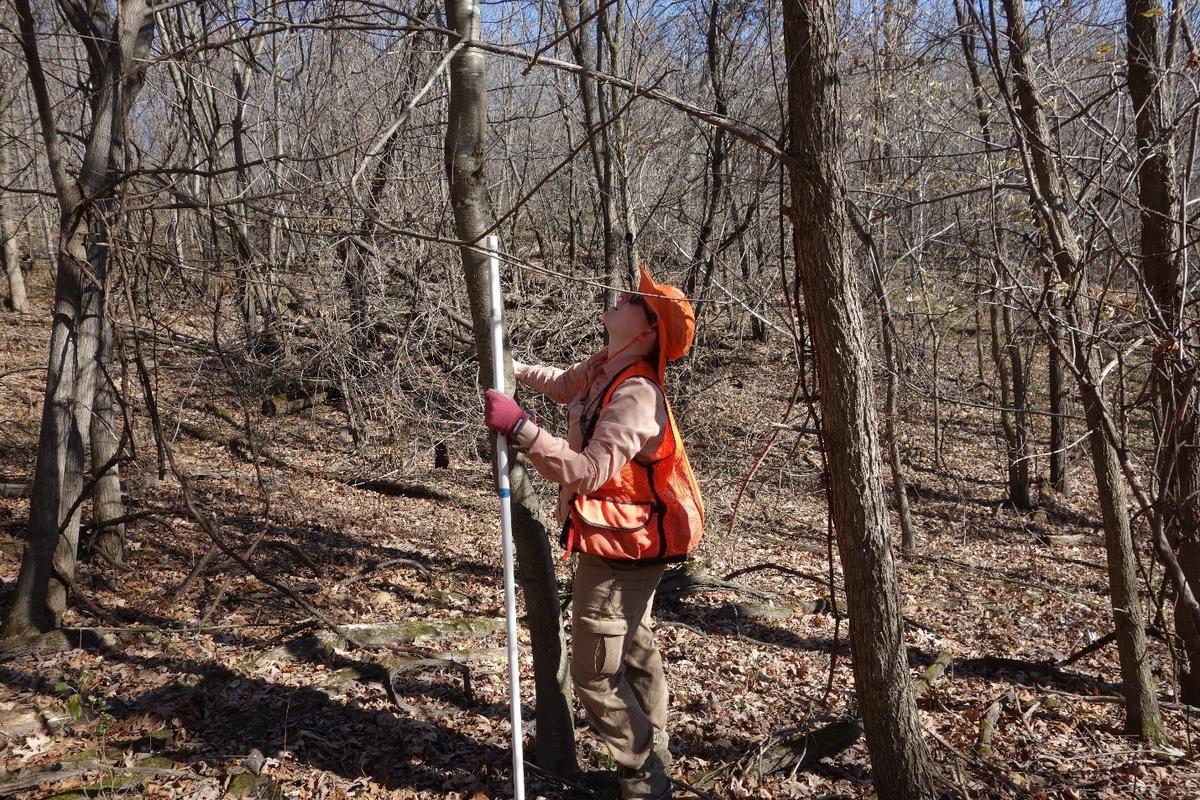Overview
In Minnesota DNR’s Lewiston forestry administrative area, a common prescription for regeneration of mature oak stands includes underplanting oak seedlings before a regeneration timber harvest. We wanted to do an assessment of how well the practice had met oak regeneration objectives by gathering current data on several sites that had been underplanted with oak. This study is an assessment of oak regeneration and overall stand condition in 2021 (14 years after planting and harvest) for one of those sites.
Background on typical oak regeneration through pre-harvest underplanting prescription:
Seedlings have been planted prior to harvest (instead of after) because:
- They become established for a year or two, helping them be better able to grow and compete with other vegetation after exposure to full sunlight post-harvest.
- It is extremely difficult and expensive to plant seedlings after a harvest, with heavy amounts of slash on the ground.
- Non-oak species such as black walnut are mixed into plantings as appropriate for the site.
- Most often, the harvest prescription has been a clearcut with reserves, although there have also been some shelterwood harvests.
- Damage to underplanted seedlings during harvesting activity is usually modest. The young stems are pretty flexible and most often survive being run over by a skidder by bending but not breaking. Those that do break off generally resprout and exhibit the rapid juvenile growth associated with sprout origin stems.
- Crop tree release of desirable young regeneration, along with thinning of oak stump sprout clumps has typically been accomplished 8 to 15 years after the harvest.
Silviculture Objectives
- Regenerate a mature oak stand to a young stand of similar composition.
- Maintain acreage of oak forest type.
- Maintain and improve wildlife habitat with a strong component of oak trees in the new stand. Oak forests provide habitat for numerous wildlife species. One of oaks’ most important contributions to wildlife is mast, or acorns which can be an important seasonal food source for many species.
- Improve timber quality and value. A good component of healthy, well-formed oaks and other fine hardwoods will help ensure high timber value at harvest time.
Pre-treatment stand description and condition
Stand establishment and management history
Most of the mature oak stands in southeastern Minnesota at the time of project initiation in 2007 originated after control of regular fires after European settlement.
The stand was part of a privately owned farmstead until the state obtained it in 1979, so it probably had a history of use as a woodlot and wooded pasture prior to state ownership.
Pre-treatment species composition
The pre-treatment stand was dominated by oak, including black, northern red, white and bur oak. Modest volumes of a mixture of other central hardwood species common to the plant community were present, including basswood, elm, hackberry, black cherry, shagbark and bitternut hickory, and a very small amount of sugar maple. See Table 1.
Table 1: 2007 Timber sale appraisal of volume of non-reserved merchantable trees with stems greater than 12 inches DBH
Species | Volume (Board Feet) |
Black Oak | 47,500 |
Red Oak | 33,500 |
White Oak | 19,000 |
Central Hardwoods | 9,000 |
Bur Oak | 2,700 |
Total: | 111,700 |
Landowner objectives/situation
While specific objectives vary from parcel to parcel, lands under the administration of DNR-Forestry are managed in alignment with Section Forest Resource Management Plans (SFRMP) to ensure that state forest management activities meet statewide goals for ecological protection, timber production, wildlife habitat and cultural/recreational values. The DNR assembles teams from the Divisions of Forestry, Fish & Wildlife, and Ecological & Water Resources who work with partners and the public to develop SFRMPs.
The Minnesota DNR goal for oak forest acreage at the time of project initiation was to maintain as much of it as possible through regeneration of mature stands.
Silviculture prescription
The following series of treatments were implemented:
Treatment | Date | Description | Acres Treated |
Silvicultural assessment and timber sale appraisal | 2006 and 2007 | Timber was appraised for sale, data was obtained on stems of existing regeneration, and the stand was assessed to determine a silvicultural strategy. | 26 |
Underplanting | Spring 2007 | Bare root seedlings were hand underplanted prior to anticipated harvest at approximately 8’ x 8’ spacing. Target density was approximately 750 stems/ acre. Records do not indicate whether the species mix was totally random across the site, or whether species were somewhat targeted for certain portions of the site. Species:
| 26 |
Clearcut with reserves harvest | 2007 | Trees greater than 12 inches DBH were harvested in a commercial clearcut with reserves harvest. Scattered trees of larger bur, white, red and black oak were reserved for mast production as a seasonal wildlife food source, to provide den and roost trees, and also as a seed source for regeneration. | 26 |
Post-sale killing of undesirable competing trees | Fall, 2009 | Stems of undesirable competing trees (boxelder, elm and ironwood) were killed by girdling with a chainsaw, and applying Tordon herbicide to the girdle wound. | 26 |
Crop tree release and oak sprout clump thinning | December 2018 | Crop tree release: Release from competing woody vegetation up to 150 well-formed, desirable hardwood crop trees (3’ and taller)/acre. In order of crop tree preference, desirable species of the following released: Walnut, Oak, Shagbark Hickory, Bitternut Hickory, healthy Butternut, Cherry, Hackberry, Sugar Maple, Silver Maple, Kentucky Coffeetree, Basswood, Cottonwood, Paper Birch and Aspen. Mast producing species take priority over non mast trees. Sprout thin: Mechanically cut stump sprout(s) of Crop Trees to the one best formed sprout near the base of the stump. | 26 |
Invasive species control | 2018 | Treat the following invasive exotics/non-desirable species with herbicide: all buckthorn, black locust, honey locust, multiflora rose, amur maple (ginnala) and non-native honeysuckles taller than 3’ tall, barberry taller than 2’, Oriental bittersweet and grape vines 1” diameter and larger. | 26 |
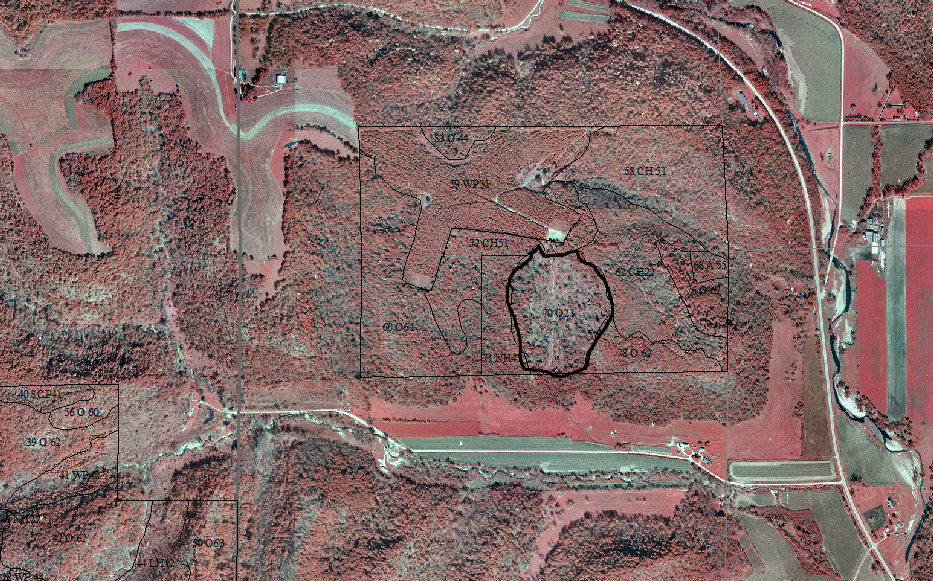
Figure 1: Color infrared aerial photograph of study site (heavy black outline) and surrounding area
What actually happened during the treatment
As far as we can tell now from existing records, everything went largely as planned per the prescription.
Post-treatment assessment
Regeneration
The silvicultural prescription of pre-harvest underplanting, a clearcut with reserves harvest, and crop-tree release 11 years after harvest has resulted in a young stand consisting of mixed hardwood regeneration as of 2021
14 years after initial treatment, there was a mixture of desirable hardwood regeneration (Table 2). A fair number of these seedling and sapling stems are above deer browse, with many clearly at “free to grow” status.
Desirable hardwood species regeneration includes red oak, black cherry, basswood, hackberry, black walnut, shagbark hickory, and (on a small portion of the site) sugar maple. Other species present include elm, bitternut hickory, ash, trembling aspen, paper birch, black locust and butternut.
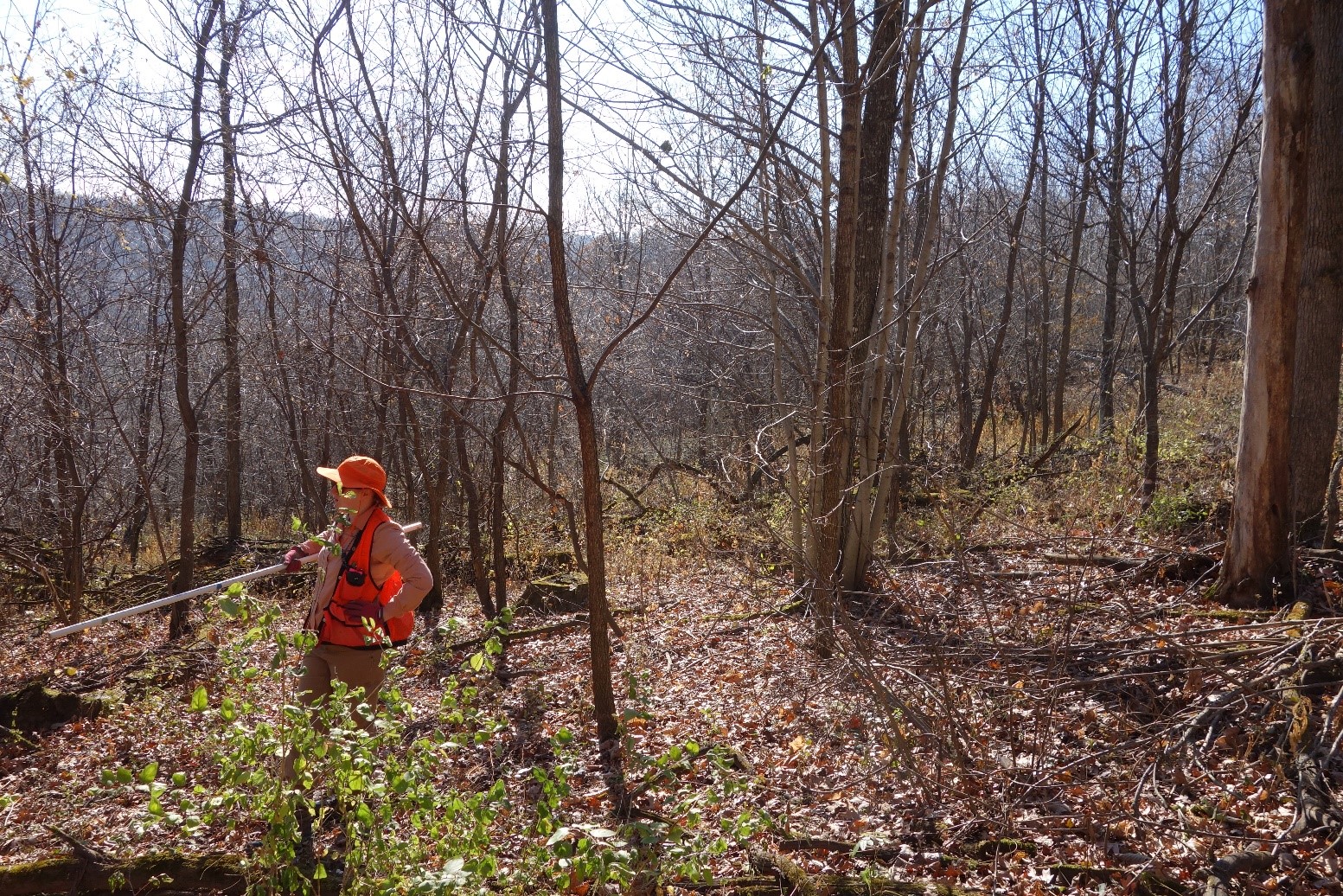
Figure 2: Michelle Martin among mixed hardwood regeneration in fall 2021. Note the black walnut stem behind her.

Figure 3: Michelle Martin measures a regenerated black cherry stem among other regeneration in fall 2021
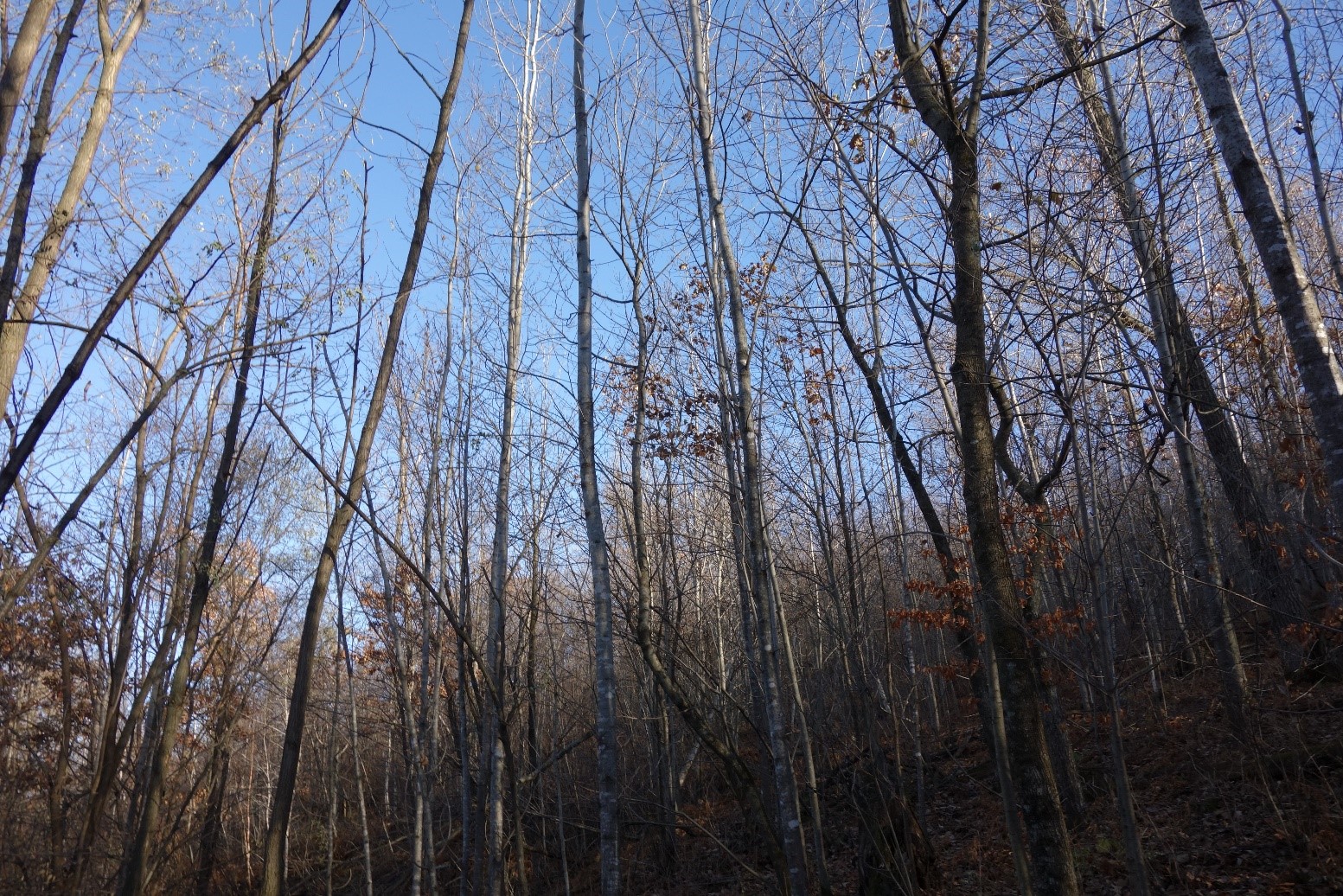
Figure 4: Abundant stems of mixed species regeneration in the fall of 2021
While there is an oak component in portions of the stand, it is not as abundant or well-distributed as we would like
It is important to note that while this is now well on its way to becoming a healthy mixed central hardwoods stand, the oak component is considerably less than we were hoping for. And we also need to note that the majority of the larger stems of oak regeneration present are of coppice, not planting origin. This is in spite of early post-planting regeneration data in 2009 showing the presence of good numbers and distribution of red oak saplings (Table 3). The oak mortality between the years 2009 and 2021 indicates clearly that additional release from understory competition in the early years after planting (and probably also deer browse protection, typically annual bud capping) would have been necessary for more oaks to recruit into larger size classes.
We want to note that the crop tree release work 10 years after harvest was important for allowing oaks and other desirable shade-intolerant species to survive and thrive. However, an earlier release would have been better.
Foresters will continue to monitor and assess the site over time. They should have options to adjust species mix as desired through future crop tree release/thinning treatments.
Table 2: Regeneration Summary: Trees/Acre and Plot Frequency by Species and Size Class
Size Class | < 1’ tall | ≥1’ tall and < 1” DBH | 1” to 3” DBH | 3” to 5” DBH | ||||
Species | Stems/ Acre | Freq | Stems/ Acre | Freq | Stems/ Acre | Freq | Stems/ Acre | Freq |
Ash | 129 | 12.9% | 484 | 29.0% | 48 | 9.7% | 23 | 19.4% |
Aspen | 0 | 0.0% | 0 | 0.0% | 16 | 3.2% | 10 | 6.5% |
Basswood | 32 | 3.2% | 129 | 6.5% | 16 | 3.2% | 12 | 12.9% |
Bitternut Hickory | 0 | 0.0% | 32 | 3.2% | 16 | 3.2% | 19 | 12.9% |
Black Cherry | 32 | 3.2% | 226 | 16.1% | 32 | 6.5% | 35 | 29.0% |
Black Locust | 0 | 0.0% | 0 | 0.0% | 48 | 6.5% | 3 | 3.2% |
Black Walnut | 32 | 3.2% | 32 | 3.2% | 16 | 3.2% | 10 | 6.5% |
Boxelder | 0 | 0.0% | 32 | 3.2% | 48 | 9.7% | 26 | 9.7% |
Butternut | 0 | 0.0% | 0 | 0.0% | 32 | 3.2% | 3 | 3.2% |
Elm | 194 | 12.9% | 581 | 19.4% | 194 | 29% | 55 | 32.3% |
Hackberry | 65 | 6.5% | 97 | 6.5% | 48 | 6.5% | 3 | 3.2% |
Ironwood | 0 | 0.0% | 97 | 3.2% | 16 | 3.2% | 3 | 3.2% |
Paper Birch | 0 | 0.0% | 0 | 0.0% | 0 | 0.0% | 10 | 6.5% |
Red Oak (Seedling) | 129 | 9.7% | 32 | 3.2% | 16 | 3.2% | 3 | 3.2% |
Red Oak (Sprout) | 0 | 0.0% | 32 | 3.2% | 16 | 3.2% | 13 | 12.9% |
Shagbark Hickory | 0 | 0.0% | 0 | 0.0% | 32 | 6.5% | 3 | 3.2% |
Sugar Maple | 129 | 9.7% | 65 | 6.5% | 0 | 0.0% | 3 | 3.2% |
Total Stems/Acre | 742 |
| 1,839 |
| 594 |
| 234 |
|
Table 3: Fall 2009 regeneration check stems/acre by species and size class, 3 growing seasons after initial treatment
Species | Size Class 0”-.9” DBH | Size Class 1”-2.9” DBH | Size Class 3”-4.9” DBH | Total | Distribution |
Aspen | 33 | 0 | 0 | 33 | Well distributed |
Black Cherry | 33 | 0 | 0 | 33 | Well distributed |
Elm | 33 | 66 | 0 | 99 | Well distributed |
Red Oak | 0 | 200* | 0 | 200 | Well distributed |
Shagbark Hickory | 33 | 33 | 33 | 99 | Well distributed |
Total | 132 | 299 | 33 | 464 |
|
*Note: We think there was probably an error recording red oak size class in 2009. It is likely that most of the red oak should have been listed in the 0” to .9” DBH size class. This is because any red oak seedlings and even sprouts in 2009 would have been less than 1” DBH.
Residual overstory trees
We were most interested in regeneration for this study, so residual overstory trees are not a major part of the story here. However, we want to include data on residual overstory trees to give a full picture of site conditions. The data in Table 4 below shows basal area of residual tree stems in the study area.
Table 4: Basal area (ft2/ac.) of trees > 5” DBH by species and diameter class
| Diameter Class |
| |||
Species | 5-10” DBH | 10-15” DBH | 15-20” DBH | >20” DBH | Total |
Ash | 0.0 | 0.6 | 0.0 | 0.0 | 0.6 |
Basswood | 1.9 | 0.0 | 0.0 | 0.0 | 1.9 |
Bitternut Hickory | 0.6 | 0.0 | 0.0 | 0.0 | 0.6 |
Black Cherry | 1.3 | 1.0 | 0.0 | 0.0 | 2.3 |
Black Locust | 1.0 | 0.0 | 0.0 | 0.0 | 1.0 |
Black Walnut | 0.3 | 0.0 | 0.0 | 0.0 | 0.3 |
Bur Oak | 0.0 | 0.6 | 0.0 | 0.0 | 0.6 |
Butternut | 1.3 | 0.0 | 0.0 | 0.0 | 1.3 |
Elm | 0.3 | 0.0 | 0.0 | 0.0 | 0.3 |
Hackberry | 2.6 | 0.3 | 0.0 | 0.0 | 2.9 |
Red Oak | 1.3 | 4.2 | 10.0 | 1.6 | 17.1 |
Shagbark Hickory | 1.3 | 1.9 | 0.6 | 0.0 | 3.8 |
Sugar Maple | 0.0 | 0.0 | 0.3 | 0.0 | 0.3 |
White Oak | 1.0 | 1.3 | 1.6 | 0.0 | 3.9 |
Total | 12.9 | 9.9 | 12.5 | 1.6 | 36.9 |
Invasive Species
Black locust: in spite of past control efforts, we found one patch of black locust regeneration in the stand as of 2021.
Buckthorn: in spite of past control efforts, we found some buckthorn on 29% of our sample plots as of 2021. See Table 5.
Table 5: Buckthorn stems/acre and plot frequency by size class in 2021
Size Class | < 1’ tall
| ≥1’ tall and < 1” DBH
| 1” to 3” DBH
| 3” to 5” DBH | ||||
Species | Stems/ Acre | Freq | Stems/ Acre | Freq | Stems/ Acre | Freq | Stems/ Acre | Freq |
Buckthorn | 355 | 12.9% | 581 | 19.4% | 97 | 9.7% | 0 | 0.0% |
We will continue to monitor invasives and treat again if necessary.
Plans for Future Treatments
Monitor the stand through periodic inventory surveys. Harvest and regenerate the stand when it is selected in the forest planning process.
Costs and economic considerations
Costs
2007 underplanting: $9,083.30 total $ 363.33/acre
2009 post-sale kill competing trees: $5,200.00 total $ 200.00/acre
2018 crop tree release, sprout clump
Thin and invasive species control: $8,670.00 total $ 333.46/acre
Total costs: $ 896.79/acre
Revenue
2007 timber sale: $22,247.50 $ 855.67/acre
Total revenue: $22,247.50 $ 855.67/acre
Other notes
We had review and editing help from MNDNR Silviculture Program Consultant Mike Reinikainen.
This case study was developed with support from the United States Department of Agriculture's National Institute for Food and Agriculture, Renewable Resources Extension Act. Project #2021-46401-35956, principal investigator Eli Sagor, University of Minnesota.
Summary
The silvicultural prescription of pre-harvest underplanting, a clearcut with reserves harvest, and crop-tree release 10 years after harvest has resulted in a young stand consisting of mixed hardwood regeneration as of 2021
In 2021, 14 years after initial treatment, there was a mixture of desirable hardwood regeneration including red oak, black cherry, basswood, hackberry, black walnut, shagbark hickory, and (on a small portion of the site) sugar maple. Other species present include elm, bitternut hickory, ash, trembling aspen, paper birch, black locust and butternut.
Foresters will continue to monitor and assess the site over time. They should have options to adjust species mix as desired through future crop tree release/thinning treatments.
While there is an oak component in portions of the stand, it is not as abundant or well-distributed as we would like
While this is well on its way to becoming a healthy central hardwoods stand, the oak component is considerably less than we were hoping for. This is in spite of adequate early post-planting and harvest oak regeneration. The oak mortality between the years 2009 and 2021 indicates that additional release from understory competition in the early years after planting (and probably also deer browse protection) would have been necessary for more oaks to recruit into larger size classes.
The crop tree release work 10 years after harvest was important for allowing oaks and other desirable shade-intolerant species to survive and thrive. However, an earlier release would have been better since it would have enabled far greater numbers of these species to survive and recruit.
Supplemental content
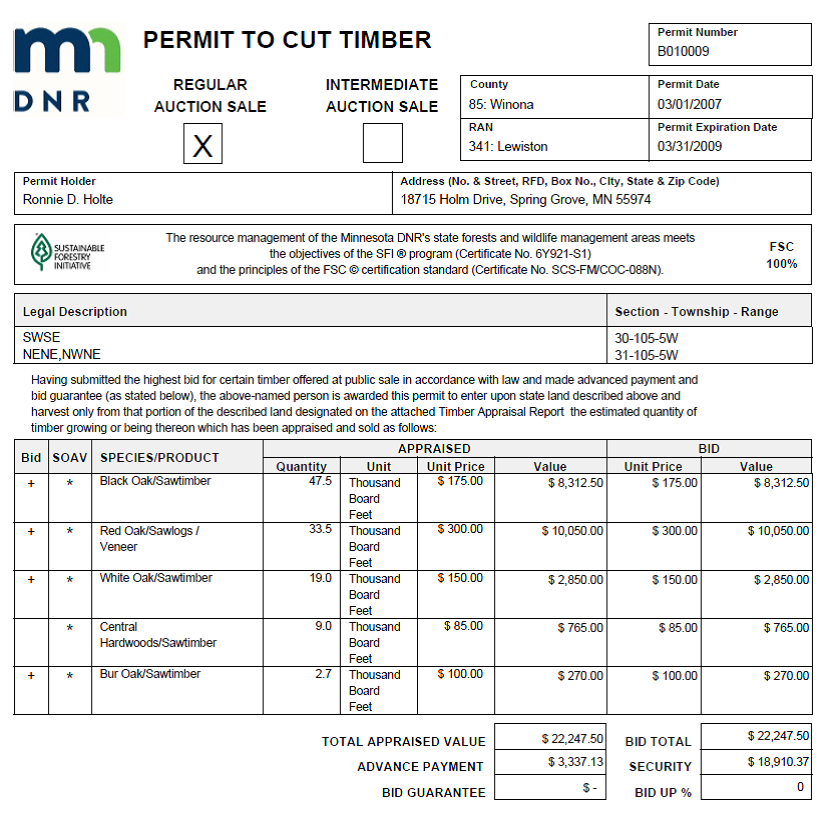
Supplemental figure 1: 2007 timber sale permit
